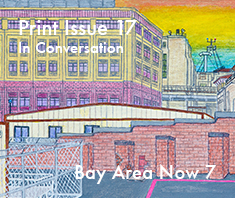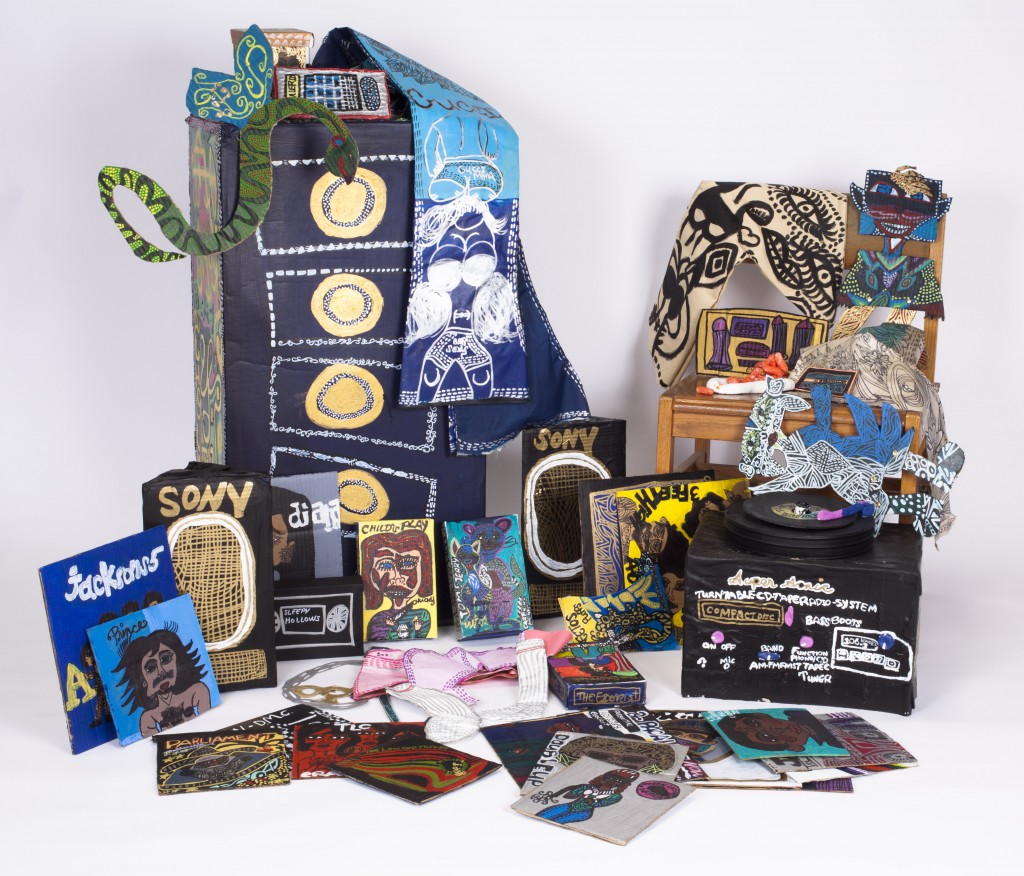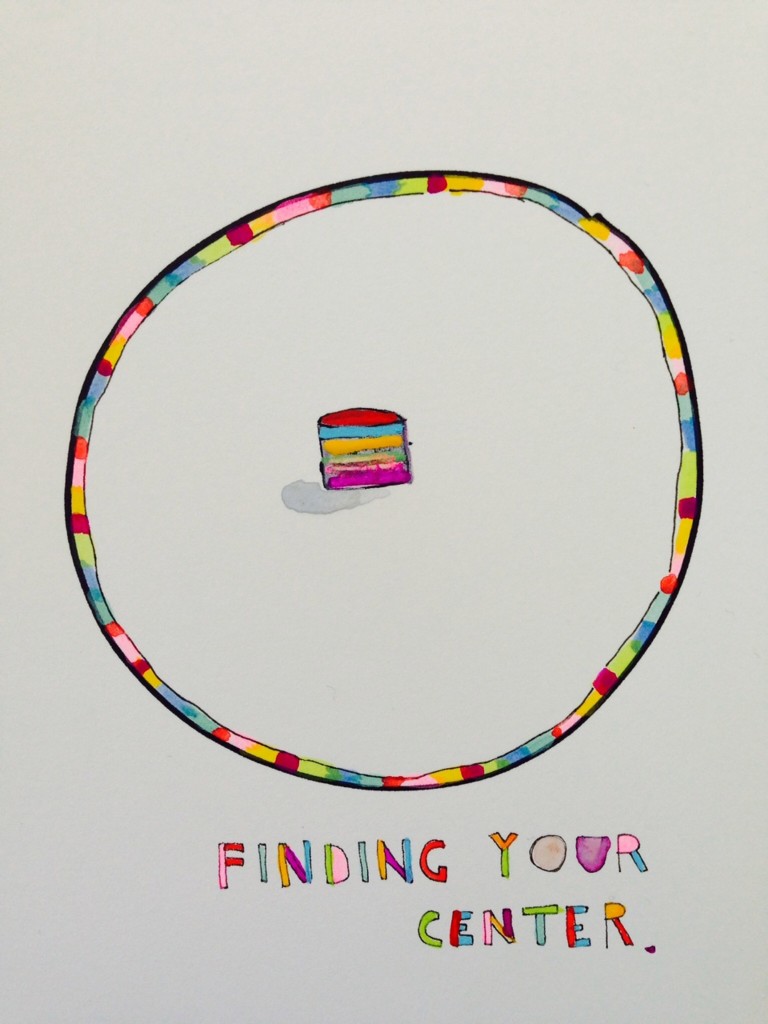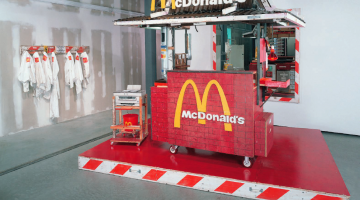Bay Area Now 7
Betti-Sue Hertz and Ceci Moss in conversation with Leora Lutz
Yerba Buena Center for the Arts
701 Mission Street, San Francisco, CA 94103
18 July–05 October, 2014
This interview has been pulled from SFAQ print issue 17.

Gary Harrell and Roy Gilstrap, “The Cell,” 2013. Mixed media diorama, 12 H x 17 W x 6 D. Photograph Courtesy Peter Merts.
Thank you for meeting with me today—we are super excited about the brand new Bay Area Now (BAN) 7 at Yerba Buena Center for the Arts (YBCA). The first question I have on my mind is the concept of “decentralized curating.” Can you define that, and tell me a little about your concept of it and how it is playing out in this show?
Betti-Sue Hertz: Let’s start with the phrase—Bay Area Now—which has usually been centered around the visual arts, but a couple of years ago we were thinking about how YBCA fits in with larger issues and organizations, such as leadership, activism, trends, non-profits, academic and also looking at how the arts feed into this creative, innovative, and intellectual community.
To see how YBCA plays a part in the community?
BH: Yes, a few years ago there was an effort to ask how the arts fit into such an innovative culture as San Francisco, and why the art community isn’t more strongly connected to some of these other things. But maybe the questions are how those things [such as leadership and activism] connected and how they can become stronger. Now the interest is in how YBCA is a leading cultural institution and what that means.
And does that support your mission statement—to be a leader?
BH: I definitely think that leadership has come up with our new director, Deborah M. Cullinan.
Ceci Moss: I think the word “center” has also come up. We are going to be rewriting our mission statement in the coming year. It’s like putting art at the center of life. It’s a term but also brings to mind what YBCA is capable of, like bringing in partners from all over the city. Another term that has come up in our curatorial conversations is “partnership.” What does it mean to partner with people, what conversations can happen here that can’t happen elsewhere, and how are we able to bring as many people to the table as possible? Working with these partners and organizations that were selected for BAN7 is an opportunity to reflect the communities and it is also a celebration of those communities.
The word center is in your name, too, so coming back to the concept of decentralized curating . . .
CM: It goes back to this concept of partnerships. We are decentralizing the curatorial process; we are encouraging more people from these communities in that we are inviting and encouraging curating from these different parts of the city. YBCA is a nexus for these different conversations and communities.
Yes, I see—YBCA is a nexus and decentralizing is a construct of how these things are going to play out.
BH: Curating as a term has been turned in many different directions. We like to say that we are the organizers of this because we didn’t make a lot of curatorial decisions. We did drive it by asking the questions to the community when we issued the open call Request for Proposals (RFPs). We posed a couple of criteria, such as artistic quality, a strong curatorial purpose, how their proposed exhibition reflects the mission of the applicant’s organization . . . then we had a jury review the 50 proposals based on the criteria that we had generated. So in a sense we had a generative role in getting the ball rolling, but once those proposals were selected, it was amazing to see how close many of the ideas are to the original proposals.
CM: The open call was generated from two open town halls that we had. We invited every organization we could think of and we asked them questions, such as “What would best serve you?” and “How can we create a strong, shared platform for the artists represented?” It was about putting artists at the center, not just about organizational voice. We wanted input on how to best do this so that it is a real partnership.
BH: And we even had some organizations that decided that they were not going to participate after all, so in a sense it was self-selecting on the part of the applicants and whether or not they wanted to be a part of this project. Applicants had the ability to be proactive. It was not like me calling up the hottest artist in town and asking them if they wanted to be in the show [laughs].
It reverses the roles—which is super exciting!
BH: What makes this round so unique is that we are working with organizations who are then working with the artists. There are also many organizations that very few if anyone on the selection committee had even heard of—and there are many new organizations that are only about two years old and even I had not had a chance to catch up with what they are doing and working on.
So let’s talk about some of these organizations for a minute. You have some from Oakland and around the Bay—William James Association’s Prison Arts Project comes to mind—and I would like to hear more about involving the East Bay and some of these other organizations and non-traditional artists and venues.
BH: BAN has always grappled with the question, “What is the Bay Area?” With BAN 7 we are engaging in different kinds of organizations that are working with, serving, and representing different kinds of populations—be it the queer community, prison populations, site-specific installation artists. This time we are all the way down in Saratoga, and all the way up in Marin, but in a meaningful way, not because we are trying to do a data analysis of the region.
A few of the proposals are from what Ceci referred to as apartment galleries such as Important Projects and n/a in Oakland, and Pied-à-terre here in San Francisco, which are important to talk about because they represent a particular type of venue that is responding to the changing landscape of the city.
CM: It is difficult to have a space with all the changes in the city—there are so many overhead costs—and a lot of artists and curators are starting to do exhibitions in their own homes.
Yes, it’s important to look at these kinds of spaces because they decentralize the institution even more than you are attempting to do yourself because their inclusion is showing the potential of the art community. We can acknowledge that we know art can be anywhere, but how can we lift those smaller places to be as reputable as the larger institution such as YBCA? It’s shifting now because these smaller places are not seen as lesser than, but just alternative.
BH: I think it is also important to see the value of short-lived organizations. It’s hard to say how long these places will last. We are an organization that is 21 years old. Although there is value in the larger institution, this exhibition allows us to show what we value in terms of the support system for artists.
So, really what’s happening is that the organizations in BAN7 are really the curators of the exhibition. The organizations have a one-to-one relationship with the artists, and their way of working is not the traditional model of selecting work, or picking it up and hanging it in a space—it’s a dialog, it’s a conversation.
BH: We are eager to get to the point where we can talk about the art and the artists! There is so much work being created for the exhibition, some of it is still being made as we speak and ideas are still coming to fruition!
And as with smaller galleries, artists are commonly making work up to the last minute, so the process for you is much more fun and dynamic I would image!
BH: We are always getting images of the new work being made for BAN, and to generate that much work is something that as a curator I find incredibly satisfying. For BAN we are to be able to work closely with the organization and deepen the directions that they are already working toward with their artists.
The curating is not only decentralized, it’s also distributed. The curatorial process [also involves] being producers and having conversations with other curators, developing the community with them. This is potentially the beginning of something much larger, because both Ceci and I have our own networks, but now it’s not just an exhibition but where it can lead all of us going forward.
CM: When we had our big retreat to discuss BAN and this [decentralized] idea was on the table, everyone’s light bulbs went off. Each curator from those disciplines also decentralized their methods by doing different things—for example the performance art curators had a nomination process, and for film Joel [Shepard] reached out to local film buffs and invited them to curate their own screenings here. What that means is that what we are doing as a whole is what is really happening in the Bay Area.
What I see is that it is taking a lot of the concerns and busting it open and giving something new a try. Maybe all of the questions can’t be answered right now; you have to see how it all plays out. With that said, it is a definite move forward . . .
BH: By inviting all of these different groups to participate in one space, [we bring] enough variety and enough of us that we can start to look together at this collective art world that we participate in. The other thing is that these places are all over the map, so it is unlikely that the visitors to YBCA would have gone to but a few of them. So it’s about visibility and strengthens the sense that we do have a dynamic arts community here. Sometimes the arts feel like they are lacking visibility because it is so spread out. Bringing it all together is like a mall: “one-stop shopping.”
Ah! I was wondering what you were getting at by using an art fair analogy on the BAN 7 page of the YBCA website. Art fairs are notorious for being commodity driven art moments in a short amount of time, in this cubby style mall setting and as you say, “one-stop shopping.” I’m not convinced that art fair is the best term to use for BAN 7. Does using that term bring up problems that you may not want to address?
CM: One of the organizations that I was looking at was the No Soul for Sale—A Festival of Independents event [Tate Modern, 2010] as a model. There were people doing a lot of exciting things, so it made me curious what would happen if we did something like that on a local level. It didn’t feel like an art fair at all, it felt like a happening. There was aliveness there, and it wasn’t about consumerism it was about visibility.
BH: I use that term because it is commonly understood as a place where you can go and see a lot of things. What I experience when I go to fairs, beyond the market aspect of it, is that I get to see a lot of different things at once from a lot of different parts of the world. I think this is an easily understood idea. And there is a lot to talk about in the art world as fairs become a dominant way to see art. I was at the Art Basel fair in Hong Kong and there were 60,000 people there to see art with very little contextualization, very little interpretation—everything there is clearly for sale, right? But, swarms of diverse people were at this fair—school groups, tons of families—so the potential of taking the popularity of that and turning it toward some very serious art and curatorial practice is something to think about.
Yes, I even saw things happening at artMRKT in San Francisco that I had not seen happen at a fair, and it speaks to the fact that even art fairs are changing, and that people want more than just the consumer experience.
BH: And there is another conversation there about how the art fair is affecting museum culture. I feel that the art fair attracts a broader spectrum of people than who would normally visit a museum because of its mall likeness. This region isn’t necessarily dominated by mall culture anyway, but in the end it will open up conversations about coming together.
Yes, that totally makes sense when you explain it that way. Another point I want to bring up is your use of the term site-specific. YBCA is a big institution with its own meaning, so inserting an art fair structure into it and calling it site-specific is a bit confusing. Art fair conjures up cubicles, so how is the space going to be used? And how does one depart from the site-specificity of the museum itself?
CM: In the open call we asked people where they wanted to be within the space, and to be creative and not just think of it as a white cube. For example, Montalvo [Arts Center] is working with Leah Rosenberg who is doing a bunch of interventions throughout the space. Susan O’Malley is doing an experimental tour throughout the space, and Pied-à-terre is showing a small white painting by Teresa Baker and the whole point of it is looking at the light and shadow as it changes over time. People were really thinking about space creatively and turning it on its head.
BH: Perhaps saying that the exhibitions are sited in a specific place is a looser way of saying it.
The organizations are behooved to do exhibitions at their own spaces that coincide with BAN, which is great because it encourages visitors to go seek out these other spaces, reinforcing the whole point of what a cultural center should be doing.
CM: Yes, and there is a shared space in the exhibition called The Commons where people can put flyers and handouts of their other events and visitors can hang out and get takeaways.
That sounds excellent! I’m curious about the idea of now, and is three years between each BAN really highlighting the current trends without considering the previous three years’ great achievements? Are there any commissions for BAN7?
BH: Estria Foundation in Oakland, which organizes mural exhibitions, are going to be presenting six works that are from previous exhibitions. We also commissioned one of their artists to create a new mural. The artist is Miguel Perez and his graffiti name is Bounce. It is going to be hung outside where we usually have marketing banners. It is for this exhibition, but currently it will be up until 2015. That was one of the institutionally driven projects because there is a push here to do more public art and to mark our building an art center.
CM: Each organization received a $2500 stipend to produce work.
BH: Each organization has a different relationship with their artists, and they were given a flat fee to distribute how they saw fit.
It’s great that you are recognizing the financial need. So, another thing that I noticed about the programming is that each facet of the exhibition is seen as its own art form. There are categories of visual art, performance, film, and engagement, and within each of those are different exhibitions and events . . .
CM: Every Free Third Thursday Converge event will have a number of organizations doing different things. For example, the Bay Area Art Workers Alliance are going to perform dance pieces in August, Second Floor Projects is going to organize a screening by Johnny Ray Huston and a reading of Curt McDowell’s work that is going to be presented by his sister Melinda McDowell. Nicolas Sung will be delivering fresh flowers each week for the installation and Publication Studio from Oakland is bringing their printing press here and Ian Dolton-Thornton will be working in their space. Also, Important Projects is doing a mural with YBCA staff and looking at labor and institutional hierarchies.
BH: And Bay Area Workers Alliance is also making an institutional critique.
CM: In fact, it was really important for them to list all of the artists affiliated with their organization as a way to recognize and to share ownership with the exhibition even though not all of the members are participating in it.
BH: You know, we can sit and have assumptions about what is important to artists, and those assumptions may not be right. For example, we might think that gentrification or Ellis Act evictions are really on peoples’ minds, but what the artwork is doing is much more subtle and very poetic. So if we look across these various visual sectors, it makes a lot of sense that the idea of visibility/invisibility is something to talk about.
CM: This makes me think of the San Quentin Projects is hanging a huge salon-style installation as a political gesture.
BH: And once the shows are up we can make more layers and begin to see all of the connections. A lot of threads started to emerge that we didn’t even plan—that is one of my favorite things.
My view as a writer is to find those threads too, and to gurgle up these concepts of invisibility and visibility—but I also see opened doors and closed doors, coming and going. What I am getting at is the use of the space—others being allowed to occupy the space with the ownership of their identity, their walls, and being able to come in and represent themselves. And these logistical issues are a part of demystifying the museum.
BH: I see this as fifteen shows within the show—I’ve actually never done anything like this be- fore. It brings up the idea of ownership, and the concept that even people not formally trained in curating can take on the role of curator. The term has been opened up to a lot of people and the partner organizations are all really excited and grateful for this opportunity!
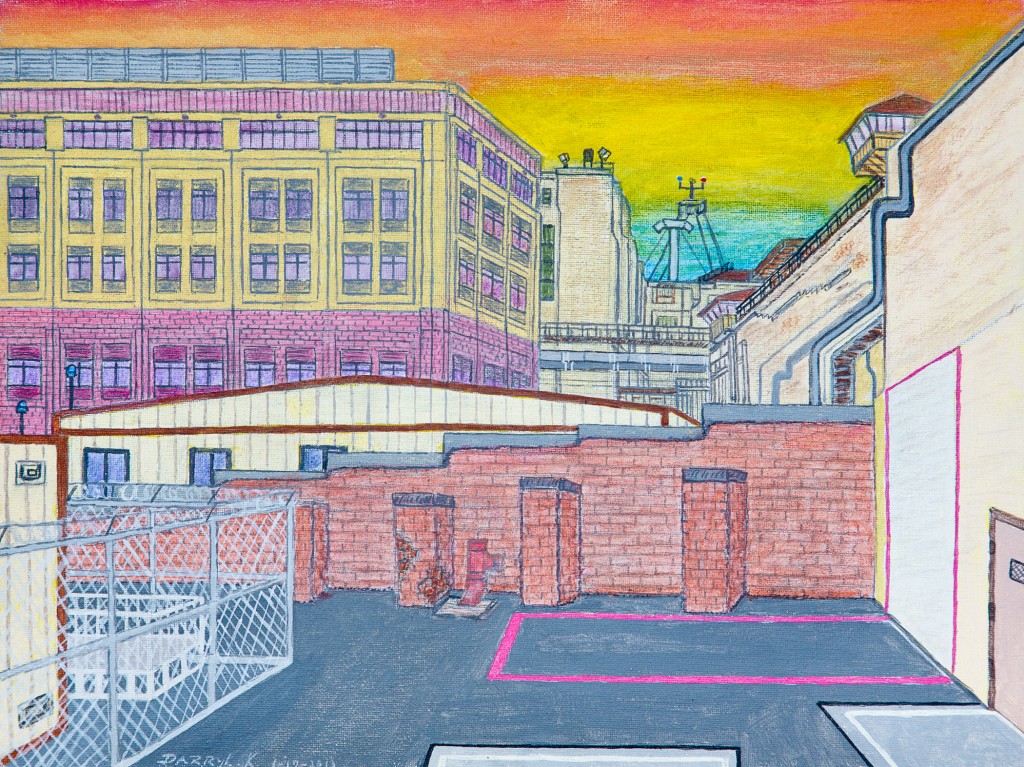
Darryl Kennedy, “San Quentin Under Armageddon Skies,” 2013. Acrylic, 12H x 16W. Courtesy of the artist.
Previous contributions by Leora Lutz include:
Review: Marco Maggi, “West vs East” at Hosfelt Gallery, San Francisco
Review: Ala Ebtekar, “Parallax” at Gallery Paule Anglim, San Francisco
